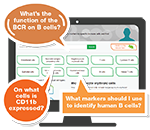Antibody Application Resources
s
s
Interactive Tool

Human and mouse immune cell marker databases. All the facts at your fingertips from cell lineage to marker proteins, discover for yourself.
Application Resource Overview
At Bio-Rad we aim to provide you with a reliable source of antibodies and support you with the design and optimization of your experiments. To help you achieve success, we have developed a range of useful application-specific resources, such as guides, protocols and tips, for:
Supplemental to the resources below, we have an extensive collection of recommended application-specific protocols for you to utilize, and a full range of antibody resources to cover your wider antibody requirements.
You can access our antibody application-specific resources by clicking on the relevant sections below.
Flow Cytometry
Flow Cytometry Workbook
This Flow Cytometry Workbook consists of 10 modules that will teach you the principles of flow cytometry, and will equip you with crucial knowledge to get the most from your experiments. To test your understanding, take a quiz at the end of each module.
UPDATED Flow Cytometry Guide
New to flow cytometry or wanting to expand your knowledge?
The new, updated Flow Cytometry Basics Guide has it all covered. From an introduction to basic flow cytometry principles, practical advice for planning and optimizing your experiments, to examples of conventional and spectral multicolor panels. Ideal for beginners and for use as a teaching aid.
Pocket Guide to Flow Cytometry
A pocket version of our popular Flow Cytometry Basics Guide containing a basic overview of all the important features of flow cytometry, from instrument to experiment.
Flow Cytometry Protocols
Discover a selection of flow cytometry protocols for direct and indirect staining of cells and blood. We also provide several protocols for intracellular staining.
Flow Cytometry Tips
Tips to help you with the design of multicolor FC panels. From choosing the brightest fluorophores to using tandem dyes when designing panels of eight or more colors.
Intracellular Flow Cytometry Tips
Tips for the optimization of intracellular flow cytometry staining results using Leucoperm Reagent.
Flow Cytometry Controls
An overview of what an isotype control is, when and how to use it and what additional controls to perform in your flow cytometry experiments.
Fluorophore Reference Chart
Detailed information about the excitation and emission maxima of all fluorophores available from Bio-Rad.
Gating Strategies
A guide to common flow cytometry graph outputs and how, in a few simple steps you can identify different cell populations.
Cell Frequencies
Handy reference tables for human, mouse, and rat tissues commonly used in flow cytometry.
Antibody Titration
Save money and improve your data by learning how and why you should titrate your antibodies.
Antigen Density
Information and protocols to allow you to calculate antigen density, includes data for common markers used in flow cytometry.
Fluorescent Spectraviewer
Find the right fluorophore for your application using our new interactive, fluorescent spectraviewer with hundreds of fluorophore to choose from.
Multicolor Panel Builder
Build multicolor flow cytometry panels in just a few simple steps.
Western Blotting
Western Blotting Guide
A useful Western Blotting Guide covering the core process, troubleshooting, and quantification steps. A great resource to gain a quick overview of this popular laboratory technique.
Western Blotting Protocols
Learn how to perform the different western blotting steps with our protocols and hands-on video showing SDS-PAGE separation of proteins.
Western Blotting Controls
An overview of what a loading control is, why they are crucial, and how to select the right loading controls for your western blotting experiments.
ELISA
ELISA Guide
Our guide includes basic ELISA procedures, different types of ELISA, detection, results, and sensitivity.
ELISA Protocols
Protocols for sandwich ELISAs, direct, indirect, and competition ELISAs.
ELISA Tips
A selection of helpful ELISA tips which include, setting up your ELISA, consistency between wells, advice on buffers, antibodies, coating, samples, blocking, and washing.
ELISA Troubleshooting
A table of typical ELISA related problems, showing the possible causes and solutions to achieve successful results.
Immunofluorescence (IF)
Immunofluorescence Tips
A selection of helpful IF tips which include microscope compatibility and fluorophore selection based on quantum yields and photostability.
Fluorophore Reference Chart
Detailed information about the excitation and emission maxima of all fluorophores available from Bio-Rad.
Immunohistochemistry (IHC)
Immunohistochemistry
Protocols
A selection of protocols for performing various immunohistochemistry techniques ranging from IHC-paraffin to IHC-frozen.
Immunohistochemistry Tips
Tips to help you with the optimization of your immunohistochemistry experiments.
Immunohistochemistry
Controls
Crucial controls to help you optimize your IHC experiments.
Mastering IHC Staining Experiments Webinar
A webinar of IHC protocol steps, the most common pitfalls and hands-on tips on how to troubleshoot this complex type of experiment.
Immunoprecipitation (IP)
10 Tips for improving the wb detection of IP samples
We know how challenging IP experiments and the detection of IP samples by WB can be at times. That is why we have developed a set of tips to help you with your experimental design.
Western Blotting Detection of IP Samples Pocket Guide
Our new pocket guide contains a set of steps to help you with your experimental design.
Clean WB Detection of Immunoprecipitation Samples
The video outlines the different steps in an IP procedure using SureBeads Magnetic Beads and highlights how you can use TidyBlot Western Blot Detection Reagent to mitigate masking from IgG heavy and light chains.
General Applications
Antibody Advice Guide
Become an antibody expert and improve your experiments with the new Antibody Advice Guide. This comprehensive practical guide provides an introduction to antibodies and information on how to select, handle, and use them effectively, with links to helpful tools and protocols.
Secondary Antibody Guide
Secondary antibodies are essential detection reagents in many applications. The guide is designed to help you find relevant information to optimize your experiments to ensure you get the right answers.




